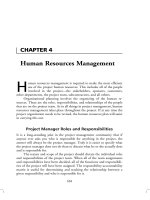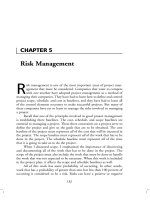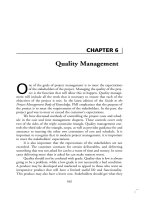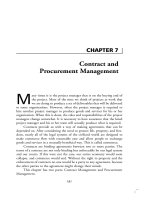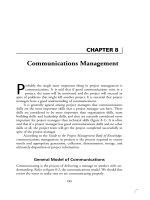Tài liệu Project Management Professional-Chapter 6 ppt
Bạn đang xem bản rút gọn của tài liệu. Xem và tải ngay bản đầy đủ của tài liệu tại đây (142.52 KB, 16 trang )
CHAPTER 6
Quality Management
O
ne of the goals of project management is to meet the expectations
of the stakeholders of the project. Managing the quality of the proj-
ect is the function that will allow this to happen. Quality manage-
ment will include all the work that is necessary to ensure that each of the
objectives of the project is met. In the latest edition of the Guide to the
Project Management Body of Knowledge, PMI emphasizes that the purpose of
the project is to meet the requirements of the stakeholders. In the past, the
project goal was to meet or exceed the customer’s expectations.
We have discussed methods of controlling the project costs and sched-
ule in the cost and time management chapters. These controls cover only
two of the sides of the triple constraint triangle. Quality management con-
trols the third side of the triangle, scope, as well as provides guidance for and
assurance to meeting the other two constraints of cost and schedule. It is
important to recognize that in modern project management, it is important
to meet the stakeholders’ expectations.
It is also important that the expectations of the stakeholders are not
exceeded. The customer contracts for certain deliverables, and delivering
something that was not asked for can be a waste of time and money. In some
cases delivering more than is asked for can make matters worse.
Quality should not be confused with grade. Quality that is low is always
going to be a problem, while a low grade is not necessarily a bad condition.
A product may be developed and marketed to appeal to those who want an
inexpensive product that will have a limited useful life and functionality.
This product may also have a lower cost. Stakeholders should get what they
165
166 Preparing for the Project Management Professional Certification Exam
pay for. The quality of the item means that it is indeed what it was intended
to be.
The Guide to the PMBOK defines three areas of quality management:
quality planning, quality assurance, and quality control. It is important that
a distinction be made between them.
The quality planning function is the process that determines which
quality standards should be used to accomplish the goal of ensuring that the
scope of the project fulfills the stakeholders’ expectations.
The quality assurance function is a process that monitors the overall
ability of the project to meet the expectations of the stakeholders. The pur-
pose of the quality assurance function is to provide the confidence that the
project will have the proper controls to be able to meet the standards that
are expected by the stakeholders. The quality assurance function assures that
the quality of the project will be sufficient.
The quality control function is the process that is used to measure the
specific items that must be monitored to determine that the project will
meet the stakeholders’ expectations.
The philosophy of modern quality management is that mistakes should
be prevented rather than detected. It is much better to create an environment
that prevents mistakes from happening rather than to spend much time and
effort trying to detect problems that may have already occurred. ‘‘You can’t
inspect quality into a product’’ is the phrase used to state this idea.
Quality Planning
The quality planning process must accomplish several things if the project is
to be successful. There must be an overall quality policy, or company guide-
lines, regarding projects of this type. Generally, this is the common policy
that will be used by all projects that the company will accomplish. Each
project and each interrelated project must modify the guidelines and gain
approval on changes that will be required for a particular project.
The result of the quality planning process is the quality plan. This plan
describes how the quality of the project will be assured and the functions
that will be carried out by the project team to accomplish this. The plan also
serves to provide the additional activities that will be added to the project
scope, budget, and schedule that will allow these things to happen.
The quality plan should reflect the information that is gathered
throughout the project. All of the other areas of the management of the
.......................... 9618$$ $CH6 09-06-02 14:59:30 PS
167Quality Management
project should complement the quality plan. Risk is of major importance in
the quality plan. Areas of the project that are high in risk should have a
significant influence on the quality plan.
Quality Assurance
The Guide to the PMBOK defines quality assurance as ‘‘all the planned and
systematic activities implemented within the quality system to provide con-
fidence that the project will satisfy the relevant quality standards.’’
Quality audits are performed to review certain important areas of the
project. Audits make it possible to determine what is happening in the proj-
ect and whether the project quality is meeting the standards that were deter-
mined in the quality plan.
The quality assurance function includes the means to continuously im-
prove the quality of future projects as well. Lessons learned from one project
are applied to the quality plans of future projects so that there can be an
ever-improving level of quality in projects completed by the organization.
Each member of the project team, including each of the stakeholders
of the project, is essential to the quality assurance of the project. In modern
thinking on quality it is the individual person performing work that is really
responsible for assuring the quality of the product.
Cost of Quality
As in all things in project management, there should be a favorable ratio of
benefits and cost to quality (figure 6-1). This is usually referred to as preven-
tion rather than cure. The total cost of curing a problem once it has occurred
is generally more costly than preventing the problem in the first place. It is
apparent that the potential savings between the cost of defects and the cost
of prevention are great. Generally, many of the costs of defects are not recog-
nized in an organized way to reflect their true cost. This is because when
some of the costs of these defects are recognized, the project has been turned
over to a maintenance and support function. The project team may have
been dissolved, and the members may be working on other projects. Follow-
ing is a listing of the considerations for these costs.
According to Edward Deming, ‘‘Eighty-five percent of the cost of qual-
ity are the direct responsibility of management.’’
.......................... 9618$$ $CH6 09-06-02 14:59:31 PS
168 Preparing for the Project Management Professional Certification Exam
Figure 6-1. Economics of quality.
Optimum Point
Cost of defects
Cost of inspection
Total cost
Level of inspection increasing
Cost
0
20
40
60
80
100
120
140
Costs of Prevention
Additional planning
Education and training of project team and stakeholders
Inspection and testing of the internal and external deliverables of the
project
Improved designs for quality purposes
Quality staff
Quality audits
Quality plan and execution
Costs of Defects
Scrap
Rework
Repair
Replacement of defective parts and inventory
Repairs after the delivery of the product
Loss of future business with the stakeholder
Legal issues for nonconformance
Liability for defect
Risk to life and property
.......................... 9618$$ $CH6 09-06-02 14:59:32 PS
169Quality Management
Figure 6-2. Deming’s fourteen points.
• Constancy of purpose • Drive out fear
• Adopt a new • Break down barriers
philosophy
• Eliminate need for • Eliminate slogans,
inspection targets, and the like
• Only consider total • Eliminate management
cost, not price by standards and quotas
• Improve constantly • Remove barriers to
pride of workmanship
• Initiate OJT • Institute education
and self-improvement
• Initiate leadership • Get everyone involved
Deming’s Fourteen Points
Edward Deming is probably best known for his fourteen points on quality
(figure 6-2). These guidelines were developed during Deming’s work with
Japanese industries and serve as a guideline for the practice of practical qual-
ity management.
Quality Control
The function of quality control is to monitor specific project results to en-
sure that the results match the standards that were set for the project. The
quality control function utilizes a number of techniques to accomplish this.
Many of these tools and techniques are rooted in the concepts of probability
and statistics.
Inspection is carried out by the observation of attributes or measure-
ments. An item that is supposed to be a certain size can be measured directly,
and the data regarding its dimensional size can be collected. All items ac-
cepted will be within the acceptable allowed tolerance on the item.
Items may also be inspected by attribute. In this technique the item to
be inspected is made to fit or not fit into a specially designed gauge or special
measuring device. If the part fits into the ‘‘Go’’ gauge and does not fit into
the ‘‘No Go’’ gauge, then the part is acceptable. If the part does not fit into
.......................... 9618$$ $CH6 09-06-02 14:59:34 PS
170 Preparing for the Project Management Professional Certification Exam
the ‘‘Go’’ gauge or fits into the ‘‘No Go’’ gauge, the part is considered to be
bad. All attribute inspections have a yes or no outcome.
Attribute sampling has several advantages over measurement methods.
In attribute sampling the inspection is fast and cheap, and there is little room
for mistakes on the part of the inspector. Measurements take a certain
amount of skill and concentration. As such, measurements are prone to
human errors stemming from fatigue and boredom.
For example, suppose a motor shaft has a design tolerance of 1.5 inches
and an allowable tolerance of plus or minus .015 inches for its diameter.
This means that an acceptable part will have to be between 1.515 and 1.485
inches.
To test this attribute, a gauge is constructed with a hole that has a
diameter of exactly 1.515 inches. This is a ‘‘Go’’ gauge. Parts that have a
diameter of less than 1.515 inches will fit into this gauge, and those that are
larger than 1.515 inches will not fit.
Another gauge is constructed with a hole of 1.485 inches in diameter.
Parts that fit into this gauge will be unacceptable, since their diameter is less
than 1.485 inches. This is the ‘‘No Go’’ gauge.
The inspection of shafts is quick, easy, and nearly foolproof. A part is
taken and first applied to the ‘‘Go’’ gauge. If it passes this gauge, it is imme-
diately put into the ‘‘No Go’’ gauge. If it fails to fit this gauge, it is an
acceptable part.
Sampling Inspection
Unless there are unusual requirements for extreme quality, as when death
can result from a defective part, most customers will accept a certain amount
of defects. The reason for this is stated in the law of diminishing returns. As
the desire to locate each and every defect is satisfied, it becomes more and
more costly to find them. One hundred percent inspections are expensive
and require much time and effort. In 100 percent inspections there is also
the problem of the inspection itself causing damage to some of the parts.
This entire concept is based on the fact that the customer is willing to accept
a small number of defective parts rather than pay the high cost of trying to
locate each and every defect.
This policy of allowing a few unacceptable parts must be considered
carefully. The ultimate use of the parts must be considered. In particular, it
is important that the part that is defective not create danger to life. There
.......................... 9618$$ $CH6 09-06-02 14:59:34 PS



